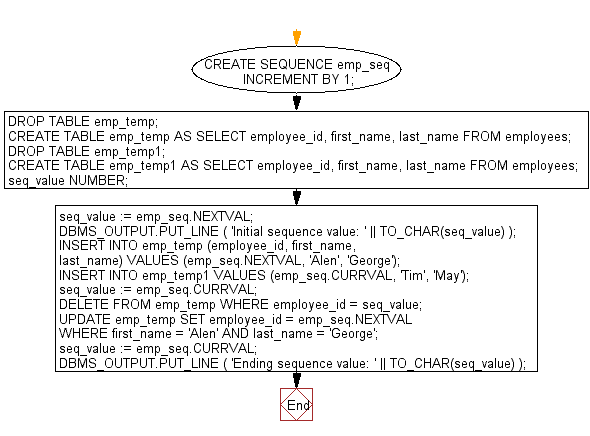PL/SQL Cursor Exercises: Show the uses of CURVAL and NEXTVAL with a sequence name
PL/SQL Cursor: Exercise-2 with Solution
Write a program in PL/SQL to show the uses of CURVAL and NEXTVAL with a sequence name.
You can generate initial sequence number by using the following sql commands.
Sample Solution:
PL/SQL Code:
SQL> CREATE SEQUENCE emp_seq INCREMENT BY 1;
/* Because NEXTVAL values might be referenced
by different users and applications,
and some NEXTVAL values might not be stored in database,
there might be gaps in sequence. */
DROP TABLE emp_temp;
CREATE TABLE emp_temp AS
SELECT employee_id, first_name, last_name
FROM employees;
DROP TABLE emp_temp1;
CREATE TABLE emp_temp1 AS
SELECT employee_id, first_name, last_name
FROM employees;
DECLARE
seq_value NUMBER;
BEGIN
seq_value := emp_seq.NEXTVAL;
DBMS_OUTPUT.PUT_LINE (
'Initial sequence value: ' || TO_CHAR(seq_value)
);
-- NEXTVAL have been used to create unique number when inserting data:
INSERT INTO emp_temp (employee_id, first_name, last_name)
VALUES (emp_seq.NEXTVAL, 'Alen', 'George');
-- CURRVAL have been used to store same value somewhere else:
INSERT INTO emp_temp1 VALUES (emp_seq.CURRVAL,
'Tim', 'May');
-- CURRVAL have been used to specify record to delete:
seq_value := emp_seq.CURRVAL;
DELETE FROM emp_temp
WHERE employee_id = seq_value;
-- The employee_id will be updated with NEXTVAL for specified record:
UPDATE emp_temp
SET employee_id = emp_seq.NEXTVAL
WHERE first_name = 'Alen'
AND last_name = 'George';
seq_value := emp_seq.CURRVAL;
DBMS_OUTPUT.PUT_LINE (
'Ending sequence value: ' || TO_CHAR(seq_value)
);
END;
/
Sample Output:
SQL> / Initial sequence value: 23 Ending sequence value: 24 PL/SQL procedure successfully completed.
Flowchart:

Go to:
PREV : Write a program in PL/SQL to show the uses of static PL/SQL statement.
NEXT : Write a program in PL/SQL to find the number of rows effected by the use of SQL%ROWCOUNT attributes of an implicit cursor.
Improve this sample solution and post your code through Disqus
What is the difficulty level of this exercise?
